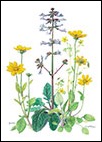
April 16
Lyre-leaved sage (Salvia lyrata)
Coreopsis (Coreopsis auriculata)
Lyre-leaved Sage has an evergreen rosette of rough textured leaves, usually quite flat upon the ground. The sturdy stem shoots up quickly in early spring. We know it is in the mint family because the stem is square. The blue flowers are about eighteen inches high; they last a long time in the garden, and even longer in a floral arrangement. But let some go to seed because they readily reseed. A large area of these blooms is a beautiful sight.
Coreopsis’ vivid yellow colors brighten the garden for about six weeks, but it too is an excellent cut flower. Plants spread by sending out stolons or runners which take root and form new plants.
Since these plants, and the little yellow wood-sorrel (Oxalis), which is also in the painting, are perennials that enjoy open places such as lawns and meadows, you may find them spreading into your lawn. The key to having a native plant landscape that your neighbors will consider civilized and cared for is to clearly define the edge where plants stop and lawn begins. Therefore, you should not let the natives invade the lawn’s neat and tidy edge. Each year, however, I find myself moving that edge, expanding the garden to replace some of the lawn area.
If your lawn has good sunlight, it probably is very pretty—as long as you are willing to feed it and then mow it, and douse it with pre-emergents, herbicides, and pesticides (which all cost money and may poison the environment). Maybe you water the lawn and mow it again, and later get out the rake or noisy leaf blower. Have you considered a meadow? A meadow takes care of itself except for the cutting of occasional bouquets and mowing once, at the end of summer. Even a three foot strip of garden along a sidewalk can be a meadow. Let the plants crowd in amongst themselves. Survival of the fittest! They will figure it out for you. The smaller plants show up to bloom early in the year. A month later you won’t even notice those plants because slightly larger plants will be blooming above them. And, by the end of summer, the asters and other tall plants have reached above all the rest to show off their blooms. Then you can mow it all down. The evergreen rosettes of the Lyre-leaved Sage and other perennials will carry your meadow through the winter.
(Click on the picture for a larger image)
(Click here for the next painting)


